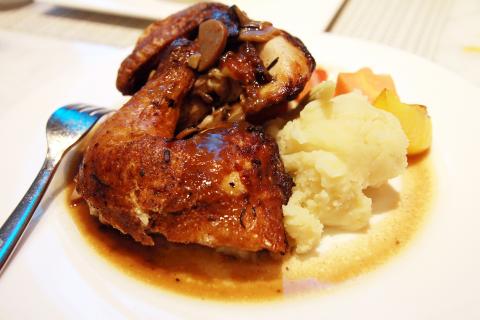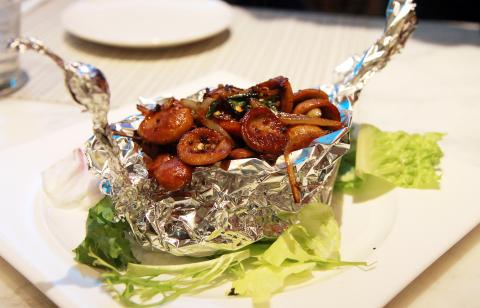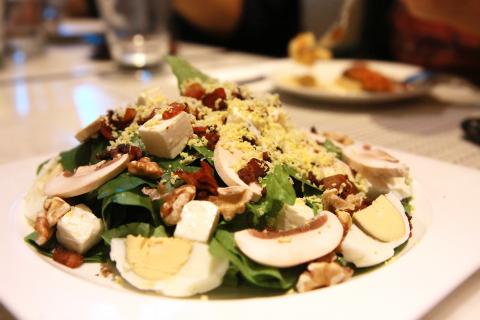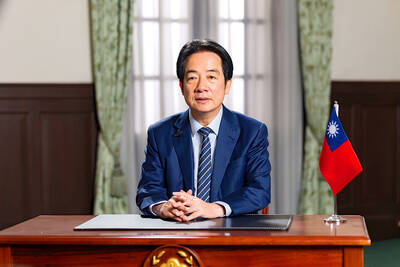The menu at LMNT Eat is bold in that it doesn’t conform to the typical Taiwanese take on Western food. It’s almost as if each dish was meticulously designed by asking Taipei’s expatriates what foods they missed, and then added a motley mixture of fresh flavors to them.
The decoration inside LMNT is bold too, but there is also an air of elegance making it romantic enough to bring a date but casual enough to entertain a colleague. Since opening last year, LMNT’s eats have been tweaked and tinkered with and a newer menu was recently unveiled. For appetizers, we started with the sauteed button mushrooms (NT$240), which were enlivened by a touch of brandy. The Buffalo wings (NT$260 for 8) were what Buffalo wings are supposed to be: meaty and spicy. They are on par with the best I’ve had in the city. The truffle mac and cheese (NT300) was also good — so good, in fact, that we ordered seconds, then thirds. It’s a rich and robust mixture of cheeses, sprinkled with bacon and coated with truffle oil.
The LMNT “Must Try” burger (NT$390) is just that. It’s thick with mushrooms, bell peppers, bacon, cheese, caramelized onions, jalapenos and an over-easy egg piled on a handmade 6oz Angus beef patty. All burgers and sandwiches come with a side of fries, salad, coleslaw or hash browns. If you go with the fries, be sure to dip them in the black truffle sauce (NT$80).

Photo: Olivia Wycech
I’m not a risotto fan, but after a few bites of the mushroom truffle risotto (NT$330), which is spiked with white wine, I reconsidered my stance. And my dining companions had to fight to get a morsel of my vodka-infused salmon penne (NT320) and creamy marinara sauce with hints of dill.
Hawaiians will be happy to see Loco Moco (NT$290) on the menu and not something with pineapple, for once. The traditional island fare is made from long grain rice and an Angus beef patty soaked in gravy. The sunny side up egg that topped off the dish made me feel as though I was eating breakfast for dinner. On to the meat and potatoes, the rosemary roasted half chicken with porcini sauce (NT$450) was so moist that the garlic mashed potatoes and seasonal vegetables were subsumed in the jus.
LMNT’s traditional steakhouse-style hunk of meat, which is charred a rich mahogany and served with seasonal vegetables and garlic mashed potatoes, is not only recommended by staff but is developing fans among its repeat customers. The 12oz rib eye (NT$980) is served with sea salt, while the 8oz filet mignon (NT$990) is swimming in a porcini mushroom sauce.

Photo: Olivia Wycech
For dessert I had the French toast baguette stuffed into a cup with banana flambe and served with a scoop of Swenson’s vanilla ice cream (NT$220). I would have never ordered the tiramisu (NT$200) myself, but we ordered one for the table and it was supple and creamy. If you prefer to drink your dessert, the hot chocolates (NT$180) are infused with your choice of apricots, raspberries, Morello cherries, blood oranges or figs.
LMNT is also offering a brunch menu that’s worth a wake up call because they offer some rarities like shrimp and grits (NT$300) and Canadian ham (NT$80). For those lucky enough to enjoy extended lunches midweek, there are four business lunch menus that rotate weekly and offer some entrees served with soup or salad and coffee or tea (NT260).

Photo: Olivia Wycech

This month the government ordered a one-year block of Xiaohongshu (小紅書) or Rednote, a Chinese social media platform with more than 3 million users in Taiwan. The government pointed to widespread fraud activity on the platform, along with cybersecurity failures. Officials said that they had reached out to the company and asked it to change. However, they received no response. The pro-China parties, the Chinese Nationalist Party (KMT) and Taiwan People’s Party (TPP), immediately swung into action, denouncing the ban as an attack on free speech. This “free speech” claim was then echoed by the People’s Republic of China (PRC),

Exceptions to the rule are sometimes revealing. For a brief few years, there was an emerging ideological split between the Democratic Progressive Party (DPP) and Chinese Nationalist Party (KMT) that appeared to be pushing the DPP in a direction that would be considered more liberal, and the KMT more conservative. In the previous column, “The KMT-DPP’s bureaucrat-led developmental state” (Dec. 11, page 12), we examined how Taiwan’s democratic system developed, and how both the two main parties largely accepted a similar consensus on how Taiwan should be run domestically and did not split along the left-right lines more familiar in

Many people in Taiwan first learned about universal basic income (UBI) — the idea that the government should provide regular, no-strings-attached payments to each citizen — in 2019. While seeking the Democratic nomination for the 2020 US presidential election, Andrew Yang, a politician of Taiwanese descent, said that, if elected, he’d institute a UBI of US$1,000 per month to “get the economic boot off of people’s throats, allowing them to lift their heads up, breathe, and get excited for the future.” His campaign petered out, but the concept of UBI hasn’t gone away. Throughout the industrialized world, there are fears that

The Democratic Progressive Party (DPP) controlled Executive Yuan (often called the Cabinet) finally fired back at the opposition-controlled Legislative Yuan in their ongoing struggle for control. The opposition Chinese Nationalist Party (KMT) and Taiwan People’s Party (TPP) acted surprised and outraged, but they should have seen it coming. Taiwan is now in a full-blown constitutional crisis. There are still peaceful ways out of this conflict, but with the KMT and TPP leadership in the hands of hardliners and the DPP having lost all patience, there is an alarming chance things could spiral out of control, threatening Taiwan’s democracy. This is no